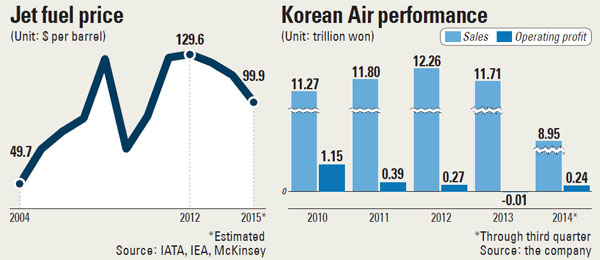Airline association foresees friendly skies in 2015

Last week, the International Air Transport Association (IATA) announced an outlook for 2015 which forecast total net profit for airlines of $25 billion, up from this year’s projected $19.9 billion.
IATA, based in Geneva, represents about 250 airlines that account for 85 percent of global traffic, including Korean Air Lines (KAL) and Asiana Airlines.
“The global economy continues to recover and the fall in oil prices should strengthen the upturn next year,” said IATA Director General and CEO Tony Tyler. “While we see airlines making $25 billion in 2015, it is important to remember this is still just a 3.2 percent net profit margin.”
Experts said the falling price of oil is the biggest factor in the growth of airline profits. The report from IATA shows the jet fuel price for 2015 is forecast to be $99.90 per barrel, the lowest since 2010.
“Next year, we forecast the airlines’ fuel bill will fall to $192 billion, which will represent 26 percent of total operating costs,” IATA said.
Local analysts also have been busy adjusting their forecasts for Korean air carriers.
A report from Samsung Securities on Thursday changed its 2015 operating profit forecast for KAL to 707.1 billion won ($643 million), up 84 percent from its previous prediction. It expects Asiana Airlines will collect 258.2 billion won, up 87 percent from a previous forecast.
“For Korean Air, fuel this year accounts about for 34 percent of total costs, but this is expected to go down to 26.1 percent next year,” said Samsung Securities analyst Park Eun-kyung. “Asiana’s costs will go down from 34.5 percent to 26.9 percent next year.”
KAL reportedly spent 4.3 trillion won and Asiana 2.1 trillion won on fuel last year.
Although it will depend on how much they have been hedging on the fuel prices, analysts said a drop of a dollar per barrel in jet fuel would boost operating profits at least 10 billion won.
“Demand for travel and cargo transportation also could increase following the drop in fuel costs and that might be reflected in ticket prices and freight fees,” said HMC Investment & Securities analyst Kang Dong-jin.
The report from IATA said consumers will benefit from cheaper travel with an average return fare (before surcharges and tax) of $458 in 2015, which would be 5.1 percent lower than this year adjusting for inflation.
“Air travel is accelerating, with growth of 7 percent expected next year, the best since 2010 and well above the 5.5 percent trend of the past 20 years,” IATA said in its report.
However, despite such rosy speculation, some industry insiders are concerned about whether recent problems will affect the image and bottom lines of KAL and Asiana.
For KAL, the infamous “nut” incident with former Vice President Cho Hyun-ah has been a headache, while Asiana is worried about a 45-day suspension of its San Francisco flight, a punishment ordered by the government as a result of an accident in 2013 that killed three people.
KAL, Korea’s largest airline, already is feeling some heat.
According to industry data last Wednesday, KAL’s reservation rate for international flights during the peak winter season from Dec. 22 to Jan. 4, was only about 70 percent, whereas Asiana’s was 87 percent.
Asiana typically has a larger percentage of seats filled than KAL in the winter, but the difference is larger this year. Last year, Asiana had an 82.8 percent reservation rate for its winter peak season international flights, while KAL had 77.6 percent.
KAL also might see fewer seats occupied as some local consumers and Korean civic groups in New York announced they will not use KAL after the “nut” incident.
For Asiana, which officially “normalized” operations after ending a voluntary debt arrangement with creditors earlier this month, the 45-day suspension of its San Francisco flight is a big concern that is expected cost 10 billion won.
“After the suspension, we can resume our convenient flight schedule and take advanntage of the good location of check-in counters that we had before,” said a spokesman from Asiana. “What’s more damaging is our public image got worse and our customers had to use other airlines during the suspension period.”
Analysts, however, said recent incidents will not heavily affect the local airlines’ stock and financial health over the long term.
“For investors, the benefit realized from oil price is drop is a bigger than issues emanating from recent incidents,” said a local analyst who asked not to be named. “Investors can be affected by psychological factors, but in the long term, it’s about financial health.”
BY JOO KYUNG-DON [kjoo@joongang.co.kr]










with the Korea JoongAng Daily
To write comments, please log in to one of the accounts.
Standards Board Policy (0/250자)